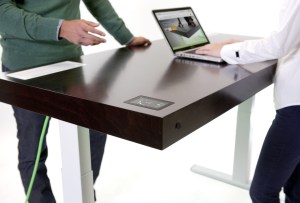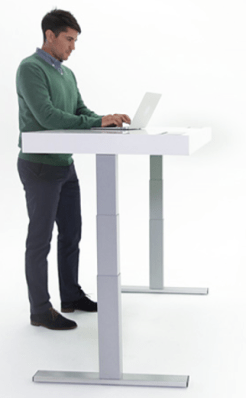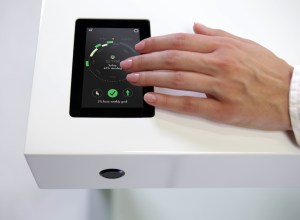The Stir Kinetic desk is like no desk you’ve ever seen before. It’s a $3,980 work surface that moves, senses your presence, learns your habits, comes equipped with a touchscreen controller, and even breathes, sort of.
Plus, of course, it looks cool in a minimalistic European style. And, it could save your life.
“Over the past years there’s been a lot of research coming out showing that sitting too much is not healthy,” Stir CEO JP Labrosse told me yesterday. “One Australian study that included 10,000 people even said that every hour spent sitting cuts 22.8 minutes off life expectancy.”
Ouch. I’m sitting right now, writing this article.
That’s one of the problems this desk is designed to fix. With built-in motors, the Stir adjusts to multiple heights, allowing you to work in an ordinary office chair, on a lower exercise ball, or standing. There are other desks that do the same, but the Stir is much more intelligent than just that.
 “We engage you, too,” Labrosse says. “The desk will invite you to change things up throughout the day, rising a inch or so, very gently, in a motion we call ‘whisperbreath.’ And the desk can track the extra calories you’re burning when standing.”
“We engage you, too,” Labrosse says. “The desk will invite you to change things up throughout the day, rising a inch or so, very gently, in a motion we call ‘whisperbreath.’ And the desk can track the extra calories you’re burning when standing.”
Apparently, standing for even half the day burns as many calories as a two-mile run, which is a good thing for those of us who hate running. Labrosse started standing around on the job when he worked for Apple on the first iPod team, reporting to Tony Faddel, who is now the CEO of Nest, the smart learning thermostat for your home. And what he learned there, he says, is that standing isn’t just about health, fitness, and not dying years earlier than you otherwise would have.
Rather, it’s about productivity.
“What I learned is that spending part of the day standing makes you feel better at the end of the day, you get more done, and it’s all very positive,” Labrosse told me. “It turns out that when you compare a group of people who spend all day sitting to a group that can move around, there’s an hour difference in terms of productivity.”
 The desk itself is simple, even elegant. All cables are hidden inside, and it has four AC power outlets in a little recess on the top left, and two powered USB plugins, so you can keep all your iDevices happily charged. The front has a thermal sensor that tells the desk when you’re there, “waking” the desk, and the desk has a custom-built Linux-based touchscreen device embedded at front left which you use to control the desk, and serves as the desk’s brain.
The desk itself is simple, even elegant. All cables are hidden inside, and it has four AC power outlets in a little recess on the top left, and two powered USB plugins, so you can keep all your iDevices happily charged. The front has a thermal sensor that tells the desk when you’re there, “waking” the desk, and the desk has a custom-built Linux-based touchscreen device embedded at front left which you use to control the desk, and serves as the desk’s brain.
As you use Stir, it learns your patterns, and starts to suggest times to stand and times to sit. With Wi-Fi integrated and an SDK coming that developers can use to integrate apps and devices with Stir, the desk will also learn from other fitness devices:
“We’ll import outside data streams to make the desk smarter — like from fitness trackers,” Labrosse says. “If the desk learns that you went for a 3-mile run before work, that will affect your activity profile and what the desk suggests for you that morning.”
And the price?
It’s certainly not cheap, and Labrosse knows it. But he’s also not apologetic. The desk is handcrafted in the United States, with the wood finished right in New York. With embedded cabling, connectivity, power supplies, and the touchscreen, it’s also a smart desk that will help you work more effectively, and certainly more elegantly.
And, of course, there’s the health and not dying part of the value proposition.
“This is really an investment in health and productivity,” Labrosse says.
 The Stir goes on sale today, and there will be a limited production run of just 50 desks, which will ship in February, with customizable color options for both the surface and the legs. If all goes well, there will be subsequent production runs after that. My guess is that this first run will be massively oversubscribed and that the company will increase the number and frequency of production runs, but that Labrosse won’t rush it.
The Stir goes on sale today, and there will be a limited production run of just 50 desks, which will ship in February, with customizable color options for both the surface and the legs. If all goes well, there will be subsequent production runs after that. My guess is that this first run will be massively oversubscribed and that the company will increase the number and frequency of production runs, but that Labrosse won’t rush it.
Great products aren’t made in moments, and he wants to get this right before getting big.
I jokingly asked Labrosse when the bike or treadmill attachment was coming, so you could not just stand, but actually exercise while working. He laughed, and said that he believed in simple products with fewer components.
“But,” he said, “There’s always aftermarket parts.”











